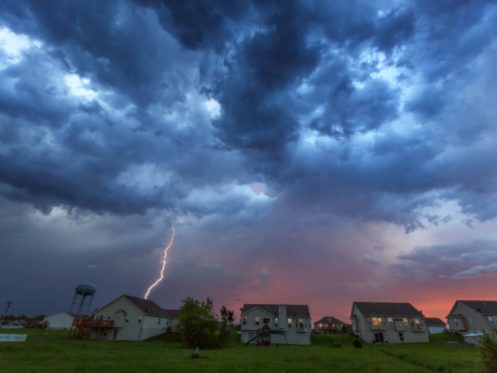Updated July 26, 2023
Installing a backup generator in your Houston, Texas home is a proactive way to prevent heating and cooling emergencies, and other potentially devastating consequences of power loss. When severe weather or other events disrupt your home’s electric service, your generator will immediately kick into action. In fact, the transfer from your home’s normal power supply to your generator could be so seamless that you barely notice it.
However, although backup generators are incredibly handy, they are not infallible. The same weather events that cause your power to go out can sometimes affect your generator too. Following is everything you need to know about how power surges and lightning strikes can impact this appliance.
It Doesn’t Take a Direct Lightning Strike to Damage a Generator
During an outage, all of the electronics and appliances that you’ve plugged in are subject to a sudden boost in voltage when power is restored. This is called a power surge. Most of the items in your home can handle a maximum of 120 volts of electricity at any given time. The average power surge far exceeds this.
Although generators are more resilient in this respect, power surges can and do affect them. Your generator has a number of electrical components that can be severely or even permanently damaged by sudden jolts of electricity.
Among these are the:
- Wiring
- Fuses
- Alternator
- Battery
- Controller
Unfortunately, it doesn’t take a direct lightning strike to cause this damage. If a transformer that’s in or even near your home’s electrical grid gets struck by lightning, this could cause a sufficient increase in the electrical current to damage both your home’s electrical system and everything that’s wired into it. Although they’re just 1 inch in diameter, lightning bolts can be as hot as 50,000 degrees Fahrenheit. They can also carry as much as 100 million volts of electricity.
Installing Whole-House Surge Protection
Installed directly on electrical panels, whole-house surge protectors react to sudden spikes in voltage within less than a nanosecond. As far as speed goes, whole-house surge protectors are on the job even before homeowners realize there’s a problem. However, standard, standalone surge protectors aren’t always capable of providing the level of protection that consumers expect. This is especially true when it comes to generators and lightning strikes.
Power surges can originate from outside of the home, such as in the case of power outages and lightning strikes. However, more commonly, these events originate from within the building’s interior. In fact, more than 80% of the power surges that the typical home experiences occur when indoor appliances turn on or off. For instance, you might hear your refrigerator kick into action and then see your lights flicker. Air conditioners, washing machines, and clothes dryers can cause these events as well. These types of power surges are known as internal transients. Homes can also experience ring wave transient surges or surges that occur due to minor changes in electric frequencies at low-voltage lines.
Thus, most options in surge protection are designed to protect against these smaller and more common surge events. After all, these are the events that have the greatest impact on consumers. Understanding this, even if you already have a surge protector installed, this doesn’t mean that your generator is safe. This is especially true if your surge protector is a device that you’ve purchased and installed on your own.
The Limitations of Whole-House Surge Protection
All surge protectors (SPs) have voltage protection ratings (VPRs). The lower a surge protector’s VPR is, the less effective it will be in high-voltage surge events. Whole-house surge protection is available in three distinct types:
- Type 1 – External surge protectors
- Type 2 – Internal surge protectors
- Type 3 – Internal surge suppressors
External surge protectors are installed outside of the home at the meter base and just before the main breaker. These devices limit the flow of electricity coming into the building. Type 2 surge protectors are installed indoors at the main panel or sub-panel. Type 2 surge protection is the most popular surge protector type. Most Type 2 SPs protect against both internal transients and ring wave transients.
Finally, surge suppressors, or Type 3 surge protectors, are installed directly at outlets. In fact, consumers can purchase and install surge suppressors themselves. However, these low-cost devices are often only capable of protecting against ring wave transients and other relatively low-voltage events.
Unfortunately, none of these three surge protection types can protect your generator from lighting strikes on its own. Lightning strikes are known as random transients, and these events exceed the VPRs of all surge protection systems commonly installed in residential properties.
Creating a Multi-Pronged Plan to Protect Your Generator From Lightning
Although most SPs are woefully inadequate for this task, generators need surge protection too. Recognizing this, many generator manufacturers are now offering surge protection that’s specifically designed for their units. If you buy a brand-new generator, the best way to limit damage from lighting strikes is by purchasing one of these supplementary SPs. You should also implement a multi-pronged plan for generator surge protection that includes external surge protection at the electrical panel’s meter base and the installation of lightning rods where possible.
External surge protection will reduce or prevent damage caused by direct lightning strikes on nearby transformers. Lightning rods will provide a safe ground path for lightning that strikes near your home so that its energy is directed away from the building and away from your appliances.
Repairing Generators That Have Been Damaged By Lightning
There’s no foolproof way to protect generators from lightning damage. Fortunately, direct lightning strikes aren’t very common, and they don’t always render these units inoperable. In fact, nearly 70% of generators that are damaged by lightning can be restored to like-new condition with parts replacement alone.
It’s also important to note that neither direct lighting strikes nor indirect lightning strikes are the most common cause of generator damage. The number one cause of generator failure is insufficient maintenance. Once installed, these units are often out of sight and out of mind until they’re desperately needed. As such, in addition to establishing a multi-pronged surge protection plan for your generator, you should also schedule professional service and get caught up on all manufacturer-recommended care.





